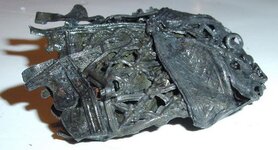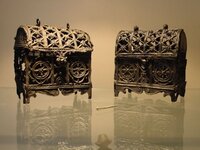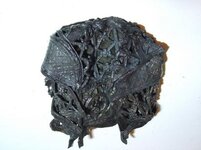woody50
Bronze Member
- Jun 21, 2007
- 1,881
- 206
- Detector(s) used
- XP Deus
- Primary Interest:
- All Treasure Hunting
I have a number of nice finds, but two that I really like are these two tin chests. I found them about 2 meters deep in the mud and black organic ground where a underground parking place was being built in one of the small towns near where I live, a number of years ago.
They were NOT in the condition you see in the photo, they were flatten out to about 1/2 inch, just smashed together because of the weight at that depth. It took me and my restorer about a month to get both of them back to (almost) their original shape, working with boiling water, wow! was that hot....
They have been determined to be about from the 1600-1650 period, although no other chest has turned up here for comparison, not even in museums.
Not large, they are 52mm x 30mm and about 55mm tall. Originally the inside of the chests were lined with what is here called Latoenkoper, in English that is brass-lamella. A few of the sheets on the side walls were still intact, but the most had gone. You can see a little if you look carefully at the 'before' photo. The copper is very thin, from about 0.02 to 0.1mm thick, so it was amazing that anything at all was left. These sheets were about 0.08mm thick.
The first photo shows one of the chests after the mud and gook was sprayed out, but before we restored it.
The second photo shows both of the chests in my display case.
What they were used for is still a mystery. In one of the chests we discovered a small pin. So a possible use could have been to hold pins, for say a dressmaker. An other idea is a child's toy. The one on the right has be valued at 4000 euros, the on the left at 3500 euros.
They were NOT in the condition you see in the photo, they were flatten out to about 1/2 inch, just smashed together because of the weight at that depth. It took me and my restorer about a month to get both of them back to (almost) their original shape, working with boiling water, wow! was that hot....
They have been determined to be about from the 1600-1650 period, although no other chest has turned up here for comparison, not even in museums.
Not large, they are 52mm x 30mm and about 55mm tall. Originally the inside of the chests were lined with what is here called Latoenkoper, in English that is brass-lamella. A few of the sheets on the side walls were still intact, but the most had gone. You can see a little if you look carefully at the 'before' photo. The copper is very thin, from about 0.02 to 0.1mm thick, so it was amazing that anything at all was left. These sheets were about 0.08mm thick.
The first photo shows one of the chests after the mud and gook was sprayed out, but before we restored it.
The second photo shows both of the chests in my display case.
What they were used for is still a mystery. In one of the chests we discovered a small pin. So a possible use could have been to hold pins, for say a dressmaker. An other idea is a child's toy. The one on the right has be valued at 4000 euros, the on the left at 3500 euros.
Attachments
Upvote
0












